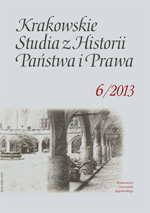Libri Feudorum und Ihr Ort in der Mittelalterlichen Rechtsgeschichte
Libri Feudorum and Their Meaning in the Medieval Legal History
Author(s): Miroslav ČernýSubject(s): Law, Constitution, Jurisprudence
Published by: Wydawnictwo Uniwersytetu Jagiellońskiego
Keywords: Corpus iuris civilis; Justinian; Libri feudorum; Accursius; Baldus de Ubaldis; feudal law; ius commune; ius proprium; Mittelater
Summary/Abstract: Feudal Law, that was originally divided and fragmented like the entire medieval feudal world in which the law was created from disparate sources, gradually found its stable place alongside rediscovered Roman law and the newly organized canon law. At first, between 1154 and 1158, Obertus dall'Orto, a consul in Milan and expert of practical application of feudal law, wrote two letters to his son, Anselm, in which he summed up the elements of feudal law. This version is known as „Compilatio antiqua”. Around 1240 he was followed by Jacopo d’Ardizzone who wrote Summa feudorum. The last work called the Vulgate or Accursiana, that was divided into two books, was then incorporated in the most privileged place, right in the glossed Justinian legislation, behind the Novellae as the tenth amendment: Collatio. The subjects of these books included feudal relations between individual persons, a description of the investiture, different kinds of fiefs and the possibility of inheriting them. However, while Roman law of glossators was beginning its second life, feudal law represented rather the type of social relationships that (emptied from its original content) was coming to an end
Journal: Krakowskie Studia z Historii Państwa i Prawa
- Issue Year: 6/2013
- Issue No: 4
- Page Range: 341-350
- Page Count: 10
- Language: German

